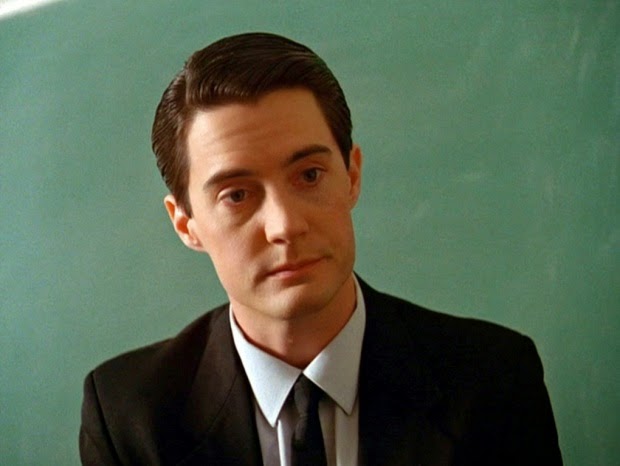This episode focuses on the main protagonist, a young, intelligent investigator called Dale Cooper (pictured below), and the disturbing dream he has about the recently murdered Laura Palmer. He has ended up in the bizarre town of Twin Peaks after being given a case there by the FBI.
(image taken from the Guardian)
Towards the end of this episode, Dale Cooper returns to his hotel room after a long day of investigation, and experiences a disturbing dream with strange and surreal dimensions to it. In this dream sequence, the audience see a red room decorated in a 70s art-deco style, with neoclassical ornaments like a Roman statue, adding to the audience's confusion and initial intrigue. There are 3 characters placed in the room, and the opening of this scene is a wide shot of the 3 sitting on chairs, the rule of thirds also applies here, which appeals to the audience visually.
The facial expressions of the 3 characters also give the viewer clues about the mood of the scene, Dale seems blank which is perhaps a projection of his dream like state, and Laura Palmer is smiling, unusually calmly composed, adding to the strange tone. The man in the middle, commonly referred to as ' the man from another place' looks delirious and excited, and gets up to dance in within the first 10 seconds of the sequence, which is something completely bewildering to the audience. In addition to the diagetic light coming from the two lamps from behind the chairs, there is what looks like a camera flash added into the scene at 10 seconds, as soon as the man in the middle starts to dance, this strobe lighting also adds a faster pace to the slow moving scene. The situation seems to get weirder and weirder as he moves to the edge, past Laura Palmer and continues to dance, with soft 40s jazz music playing in the background, a noir influence of Lynch's part although it is not clear to the audience why this is included other than to add another purely abstract element so prevalent this scene. His contorted, disjointed body movements shows an almost drug induced, hysterical state. From this, we can see contrasts of the cause of Laura Palmer's (shown in the scene) death which was partially through drugs. Having said this, it is not a clear juxtaposition, and not easy to identify at first, adding to the confusion.
After the dance sequence, at around 0.38 seconds, Laura Palmer calmly gets out of her chair and slowly walks towards Dale Cooper, there is a shot reverse shot of Laura walking towards Dale, Dale's dazed yet slightly blank facial expression and then Laura again.
In the next part of the scene Laura seems to be trying to seduce Cooper and kisses him, and to his surprise she also whispers in his ear the name of the killer, which he later can't remember. This amnesia which the audience pick up on could be partially due to the kiss acting as a distraction, but also could be because of the lighting, the strobes overpower this part of the scene and are almost blinding. Dale also wakes up straight after this, and there is a jump cut to a close up shot of him in bed waking up, so the audience automatically think it is a dream. However, there is another layer of mystery added to the scene when he starts to click his fingers to the beat of the music still playing, demonstrating a continuation of the dream sequence and reality, and therefore a struggle for the audience for the differentiation between the two. He also tells someone on the phone that he knows who killed Laura Palmer, if this was a dream then why would he take it so seriously? This, among other questions, would be something playing on the audience's mind, and it being left on a cliffhanger adds to the suspense and intrigue.




No comments:
Post a Comment